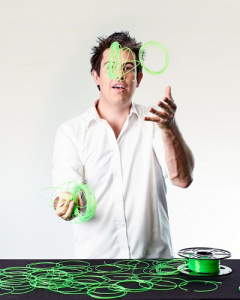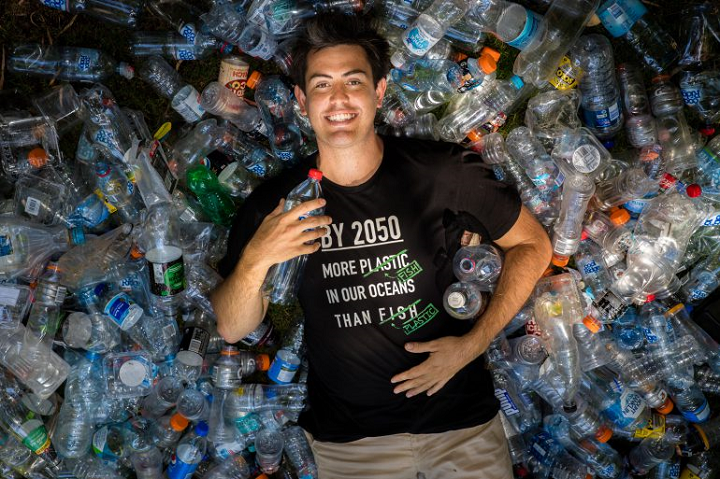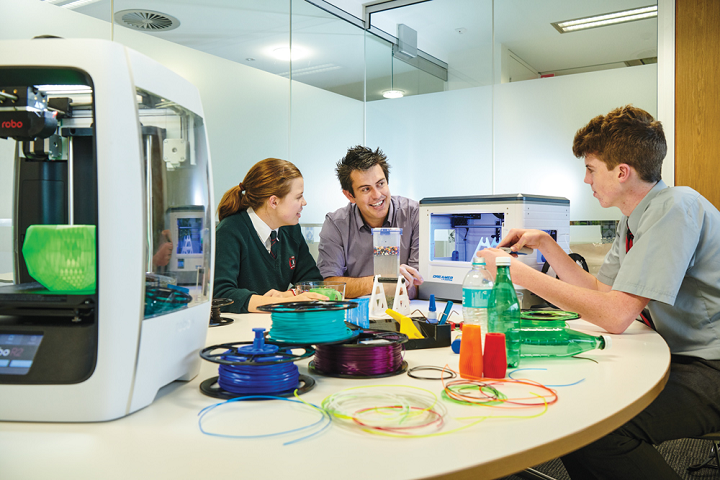Australian Entrepreneur Using 3D Printing to Help the Environment by Ridding Oceans of Plastic Waste
34-year-old Perth native Darren Lomman began his first venture when he was just 19, while studying mechanical engineering at the University of Western Australia (UWA). He launched a not-for-profit called Dreamfit, which develops equipment to help enhance the mobility of people with disabilities.
Lomman, who won the 2007 WA Young Australian of the Year for his work with Dreamfit, was the organization’s CEO for 15 years, and stayed on as Chief of Design and Innovation when it was acquired three years ago by Ability Centre, which provides services and support for disabled people in WA. But, he was soon ready to start a new adventure, preferably involving 3D printing.
Lomman said, “Dreamfit had grown so big that it didn’t need me anymore, so I decided to unclip my entrepreneurial wings.
“I had a blank canvas and could paint my own picture.”
 Then, in December 2016, Lomman saw what was for him a life-changing TV advertisement for reusable water bottles, which said that by the end of 2050, more plastic will be in our oceans than fish.
Then, in December 2016, Lomman saw what was for him a life-changing TV advertisement for reusable water bottles, which said that by the end of 2050, more plastic will be in our oceans than fish.
Lomman said, “My first reaction was that it sounded far-fetched.
“I looked it up and found that it’s actually based on scientific research. I have a 2-year-old daughter — is this the kind of legacy we’re leaving for our kids?”
Like many others, Lomman separates his waste items so his recyclables go to the right place. But after seeing the advertisement and beginning to form a plan for his next venture, he had a hard time finding a plastic recycling plant in his state. He even toured a material recovery facility and asked where the materials were sent for recycling.
Lomman explained, “That’s when I found out the truth behind our recycling industry.
“[Plastic] is put on a ship and sold through the international waste market to whoever will buy it. We have zero reprocessing in WA.”
In search of a PET recycling plant anywhere on the continent, Lomman found just one in New South Wales, and it only recycled a portion of the state’s plastics.
Lomman said, “Not a single bottle that I had put into a recycling bin has ever been recycled in Australia.
“I felt that we’d been lied to. I just thought, how the hell have we not dealt with this?”
 So Lomman decided to make a difference himself – by converting plastic waste into 3D printer filament. While this isn’t a new idea, it’s definitely a helpful one when it comes to the environment.
So Lomman decided to make a difference himself – by converting plastic waste into 3D printer filament. While this isn’t a new idea, it’s definitely a helpful one when it comes to the environment.
When his idea of creating a desktop machine that would shred and melt plastic bottles to create filament proved too expensive, he instead launched social enterprise GreenBatch, which is working to build a system that will reprocess plastic bottles into filament. Go big or go home, right?
Lomman and GreenBatch are building an industrial-scale recycling plant, and a network of secondary schools in Western Australia will collect plastic and send it to the facility. Then, once the plastic waste has been turned into filament, it will be returned to the same schools for use in educational 3D printing projects.
The original plan was for the plant to produce 300 kg of filament a week from recycled plastic, but as GreenBatch began to receive more offers of support and assistance, Lomman predicted that the plant will end up recycling about 131 million plastic bottles a year.
Lomman said, “As I’ve got more supporters onboard, we’re now scaling the plant to 300 kg [of filament] an hour.
“We’re going to have to create other product lines and we’ll keep going until not a single PET bottle leaves the WA shore, because how else can we guarantee that the plastic is not going to end up in a waste incinerator or a landfill or a river that feeds our oceans?”
Last October, Lomman launched a month-long crowdfunding campaign to help get GreenBatch off the ground, and ended up raising $70,000, which he says is “one of the biggest crowdfunding campaigns to come out of WA.”
Lomman explained, “I did not want to take commercial investors onboard with this.
“I want it to be driven by environmental gains for the community.”
WorleyParsons is contributing pro bono support for the design of the plant, while UWA has given Lomman access to its network, office space, land to build the plant on, and eight student interns.
“Darren came to us when the business was at a nascent stage and we were like, ‘wow’. We believe GreenBatch is going to become big very quickly,” said Kent Anderson, Deputy Vice-Chancellor of UWA.
If he’s successful with a recent grant application, Lomman may even be able to earn a salary soon. The enterprise’s recycling facility is still in the design stage, but should be operational by July 2019, and Lomman is “overwhelmed” by the community support he’s getting.
Lomman said, “Plenty of people say that this should be the responsibility of government.
“I put my hand up and said, ‘Hey, I’m not going to wait. I’m doing something about it.’
“It takes pigheaded determination to fight through all the naysayers and the people who don’t respond because it’s not on their radar.”
“But I’m pushing it and I’m driving it. I can’t do it on my own, but what I can hopefully do is inspire others to join me.”
For now, he’s continuing to build GreenBatch’s support network, and this summer partnered with the Million Waves Project – another organization using 3D printing to decrease the amount of plastic waste in our oceans. GreenBatch is also working with 50 secondary schools across WA, with a goal of increasing that number to 300 next year. According to Santa Maria College science teacher Hannah Fay, students working with GreenBatch are “learning vital lessons from their involvement.”
Fay explained, “From an education perspective, GreenBatch not only shows students the importance of considering their environmental impact, but it also encourages them to look beyond the standard career and into more innovative roles.”
Discuss this and other 3D printing topics at 3DPrintBoard.com or share your thoughts below.
[Source/Images: create]Subscribe to Our Email Newsletter
Stay up-to-date on all the latest news from the 3D printing industry and receive information and offers from third party vendors.
You May Also Like
Profiling a Construction 3D Printing Pioneer: US Army Corps of Engineers’ Megan Kreiger
The world of construction 3D printing is still so new that the true experts can probably be counted on two hands. Among them is Megan Kreiger, Portfolio Manager of Additive...
US Army Corps of Engineers Taps Lincoln Electric & Eaton for Largest 3D Printed US Civil Works Part
The Soo Locks sit on the US-Canadian border, enabling maritime travel between Lake Superior and Lake Huron, from which ships can reach the rest of the Great Lakes. Crafts carrying...
Construction 3D Printing CEO Reflects on Being Female in Construction
Natalie Wadley, CEO of ChangeMaker3D, could hear the words of her daughter sitting next to her resounding in her head. “Mum, MUM, you’ve won!” Wadley had just won the prestigious...
1Print to Commercialize 3D Printed Coastal Resilience Solutions
1Print, a company that specializes in deploying additive construction (AC) for infrastructure projects, has entered an agreement with the University of Miami (UM) to accelerate commercialization of the SEAHIVE shoreline...
































